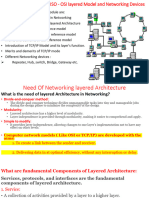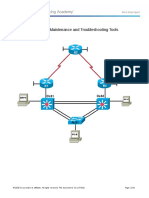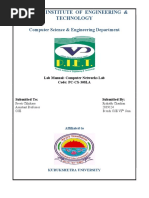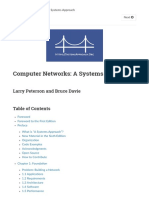Network Protocol and OSI Model
Uploaded by
when your pizza rolls are goneNetwork Protocol and OSI Model
Uploaded by
when your pizza rolls are goneIT (9626)
Theory Notes
What is a protocol?
Network protocols are sets of established rules that dictate how to format, transmit and receive
data so computer network devices, from servers and routers to endpoints, can communicate
regardless of the differences in their underlying infrastructures, designs or standards.
To successfully send and receive information, devices on both sides of a communication exchange
must accept and follow protocol conventions. Support for network protocols can be built into
software, hardware or both.
Network protocols break larger processes into discrete, narrowly defined functions and tasks
across every level of the network. In the standard model, known as the Open Systems
Interconnection (OSI) model, one or more network protocols govern activities at each layer in
the telecommunication exchange.
OSI model
OSI stands for Open System Interconnection is a reference model that describes how
information from a software application in one computer moves through a physical medium
to the software application in another computer.
OSI consists of seven layers, and each layer performs a particular network function.
OSI model was developed by the International Organization for Standardization (ISO) in 1984,
and it is now considered as an architectural model for the inter-computer communications.
OSI model divides the whole task into seven smaller and manageable tasks. Each layer is
assigned a particular task.
Each layer is self-contained, so that task assigned to each layer can be performed
independently.
Characteristics of the OSI model
The OSI model is divided into two layers:
upper layers and lower layers.
The upper layer of the OSI model mainly
deals with the application related issues,
and they are implemented only in the
software. The application layer is closest to
the end user. Both the end user and the
application layer interact with the software
applications.
The lower layer of the OSI model deals with
the data transport issues. The data link layer
and the physical layer are implemented in
www.FaisalChughtai.com +92 3008460713 info.sirfaisal@gmail.com
IT (9626)
Theory Notes
hardware and software. The physical layer is the lowest layer of the OSI model and is closest
to the physical medium. The physical layer is mainly responsible for placing the information
on the physical medium.
Functions of the OSI Layers
There are the seven OSI layers. Each layer has different functions. A list of seven layers are given
below:
1. Physical Layer
2. Data-Link Layer
3. Network Layer
4. Transport Layer
5. Session Layer
6. Presentation Layer
7. Application Layer
www.FaisalChughtai.com +92 3008460713 info.sirfaisal@gmail.com
IT (9626)
Theory Notes
1. Physical layer
The main functionality of the physical layer is to transmit the individual bits from one node to
another node.
It is the lowest layer of the OSI model.
It establishes, maintains and deactivates the physical connection.
It specifies the mechanical, electrical and procedural network interface specifications.
2. Data-link layer
This layer is responsible for the error-free transfer of data frames.
It defines the format of the data on the network.
It provides a reliable and efficient communication between two or more devices.
It is mainly responsible for the unique identification of each device that resides on a local
network.
3. Network layer
It is a layer 3 that manages device addressing, tracks the location of devices on the network.
It determines the best path to move data from source to the destination based on the
network conditions, the priority of service, and other factors.
The Data link layer is responsible for routing and forwarding the packets.
Routers are the layer 3 devices, they are specified in this layer and used to provide the routing
services within an internetwork.
The protocols used to route the network traffic are known as Network layer protocols.
Examples of protocols are IP and Ipv6.
4. Transport layer
The Transport layer is a Layer 4 ensures that messages are transmitted in the order in which
they are sent and there is no duplication of data.
The main responsibility of the transport layer is to transfer the data completely.
It receives the data from the upper layer and converts them into smaller units known as
segments.
This layer can be termed as an end-to-end layer as it provides a point-to-point connection
between source and destination to deliver the data reliably.
5. Session layer
It is a layer 3 in the OSI model.
The Session layer is used to establish, maintain and synchronizes the interaction between
communicating devices.
www.FaisalChughtai.com +92 3008460713 info.sirfaisal@gmail.com
IT (9626)
Theory Notes
6. Presentation layer
A Presentation layer is mainly concerned with the syntax and semantics of the information
exchanged between the two systems.
It acts as a data translator for a network.
This layer is a part of the operating system that converts the data from one presentation
format to another format.
The Presentation layer is also known as the syntax layer.
7. Application layer
An application layer serves as a window for users and application processes to access network
service.
It handles issues such as network transparency, resource allocation, etc.
An application layer is not an application, but it performs the application layer functions.
This layer provides the network services to the end-users.
www.FaisalChughtai.com +92 3008460713 info.sirfaisal@gmail.com
You might also like
- IFT 266 Introduction To Network Information Communication Technology Lab 17 The Hidden Network0% (1)IFT 266 Introduction To Network Information Communication Technology Lab 17 The Hidden Network4 pages
- Industrial Communication: Chapter 2: Modbus Serial100% (2)Industrial Communication: Chapter 2: Modbus Serial34 pages
- #7 Reference Models in Communication NetworksNo ratings yet#7 Reference Models in Communication Networks45 pages
- Reference Models in Communication NetworksNo ratings yetReference Models in Communication Networks7 pages
- The OSI Model - Features, Principles and LayersNo ratings yetThe OSI Model - Features, Principles and Layers7 pages
- He OSI Model - Features, Principles and LayersNo ratings yetHe OSI Model - Features, Principles and Layers6 pages
- Computer Networks Unit - 1 OSI Reference ModelNo ratings yetComputer Networks Unit - 1 OSI Reference Model42 pages
- Data Communication and Networking CEN-222: Engr M. Faisal Siddiqui Assistant ProfessorNo ratings yetData Communication and Networking CEN-222: Engr M. Faisal Siddiqui Assistant Professor61 pages
- FCHN-Module 6 - Overview of ISO - OSI Model and Networking Devices - 2022100% (1)FCHN-Module 6 - Overview of ISO - OSI Model and Networking Devices - 202233 pages
- Open System Interconnection (OSI) Network ProtocolNo ratings yetOpen System Interconnection (OSI) Network Protocol42 pages
- CIT 513: Introduction To Computer Communications: Mohammed A. SalehNo ratings yetCIT 513: Introduction To Computer Communications: Mohammed A. Saleh18 pages
- Telecommunication Networks 15B11EC611: Dr. Bhagirath Sahu Assistant Professor, JIIT, NoidaNo ratings yetTelecommunication Networks 15B11EC611: Dr. Bhagirath Sahu Assistant Professor, JIIT, Noida15 pages
- 04 Layered Architecture of Computer Networks OSI and TCPIP Model Lecture 5No ratings yet04 Layered Architecture of Computer Networks OSI and TCPIP Model Lecture 569 pages
- Lecture 1.1.1 and 1.1.2 - OSI Model and TCP-IP Model - DCNo ratings yetLecture 1.1.1 and 1.1.2 - OSI Model and TCP-IP Model - DC33 pages
- Understanding The Seven Layer OSI Model in DetailNo ratings yetUnderstanding The Seven Layer OSI Model in Detail16 pages
- CCNPv7 TSHOOT Lab3 1 Assembling Maintenance and Troubleshooting Tools StudentNo ratings yetCCNPv7 TSHOOT Lab3 1 Assembling Maintenance and Troubleshooting Tools Student44 pages
- Smart Care Service Pre-Installation ChecklistNo ratings yetSmart Care Service Pre-Installation Checklist8 pages
- ASA/PIX/FWSM: Handling ICMP Pings and TracerouteNo ratings yetASA/PIX/FWSM: Handling ICMP Pings and Traceroute10 pages
- Characteristics of Connectionless Networks: - A Host Can Send A Packet Anywhere at Any TimeNo ratings yetCharacteristics of Connectionless Networks: - A Host Can Send A Packet Anywhere at Any Time12 pages
- Wireless Unified 108AG Access Point: DWL-8500APNo ratings yetWireless Unified 108AG Access Point: DWL-8500AP4 pages
- Cisco Wireless Controller Configuration Guide, Release 8.5: Americas HeadquartersNo ratings yetCisco Wireless Controller Configuration Guide, Release 8.5: Americas Headquarters1,332 pages
- Route Redistribution Between OSPF and RIPNo ratings yetRoute Redistribution Between OSPF and RIP6 pages
- Microsoft Teams Call Flows - Microsoft Teams - Microsoft DocsNo ratings yetMicrosoft Teams Call Flows - Microsoft Teams - Microsoft Docs29 pages
- Implement Quality of Service (QoS) in Microsoft Teams clients - Microsoft Teams _ Microsoft DocsNo ratings yetImplement Quality of Service (QoS) in Microsoft Teams clients - Microsoft Teams _ Microsoft Docs5 pages
- Computer Networks - A Systems Approach - Computer Networks - A Systems Approach Version 6.2-Dev DocumentationNo ratings yetComputer Networks - A Systems Approach - Computer Networks - A Systems Approach Version 6.2-Dev Documentation3 pages
- IFT 266 Introduction To Network Information Communication Technology Lab 17 The Hidden NetworkIFT 266 Introduction To Network Information Communication Technology Lab 17 The Hidden Network
- CISA Exam-Testing Concept-OSI Architecture (Domain-5)From EverandCISA Exam-Testing Concept-OSI Architecture (Domain-5)
- Industrial Communication: Chapter 2: Modbus SerialIndustrial Communication: Chapter 2: Modbus Serial
- Data Communication and Networking CEN-222: Engr M. Faisal Siddiqui Assistant ProfessorData Communication and Networking CEN-222: Engr M. Faisal Siddiqui Assistant Professor
- FCHN-Module 6 - Overview of ISO - OSI Model and Networking Devices - 2022FCHN-Module 6 - Overview of ISO - OSI Model and Networking Devices - 2022
- Open System Interconnection (OSI) Network ProtocolOpen System Interconnection (OSI) Network Protocol
- CIT 513: Introduction To Computer Communications: Mohammed A. SalehCIT 513: Introduction To Computer Communications: Mohammed A. Saleh
- Telecommunication Networks 15B11EC611: Dr. Bhagirath Sahu Assistant Professor, JIIT, NoidaTelecommunication Networks 15B11EC611: Dr. Bhagirath Sahu Assistant Professor, JIIT, Noida
- 04 Layered Architecture of Computer Networks OSI and TCPIP Model Lecture 504 Layered Architecture of Computer Networks OSI and TCPIP Model Lecture 5
- Lecture 1.1.1 and 1.1.2 - OSI Model and TCP-IP Model - DCLecture 1.1.1 and 1.1.2 - OSI Model and TCP-IP Model - DC
- CCNPv7 TSHOOT Lab3 1 Assembling Maintenance and Troubleshooting Tools StudentCCNPv7 TSHOOT Lab3 1 Assembling Maintenance and Troubleshooting Tools Student
- Characteristics of Connectionless Networks: - A Host Can Send A Packet Anywhere at Any TimeCharacteristics of Connectionless Networks: - A Host Can Send A Packet Anywhere at Any Time
- Cisco Wireless Controller Configuration Guide, Release 8.5: Americas HeadquartersCisco Wireless Controller Configuration Guide, Release 8.5: Americas Headquarters
- Microsoft Teams Call Flows - Microsoft Teams - Microsoft DocsMicrosoft Teams Call Flows - Microsoft Teams - Microsoft Docs
- Implement Quality of Service (QoS) in Microsoft Teams clients - Microsoft Teams _ Microsoft DocsImplement Quality of Service (QoS) in Microsoft Teams clients - Microsoft Teams _ Microsoft Docs
- Computer Networks - A Systems Approach - Computer Networks - A Systems Approach Version 6.2-Dev DocumentationComputer Networks - A Systems Approach - Computer Networks - A Systems Approach Version 6.2-Dev Documentation

























































































